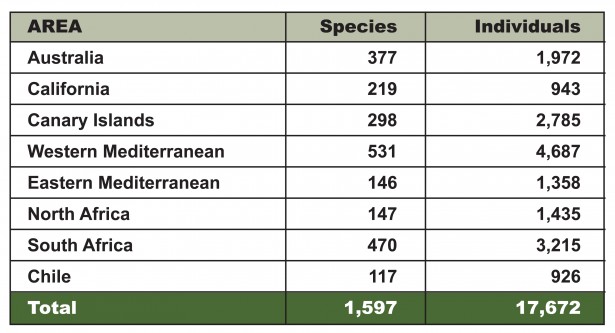The collections at Botanical Garden of Barcelona contain representative samples of the plants that grow in the Mediterranean climate, a climate characterized by marked seasonal variations, with hot, dry summers and mild winters, while most rainfall occurs in spring and summer.
Mediterranean vegetation is one of the richest in the world in terms of diversity of species. It is calculated that just 1.7% of the Earth’s landmass has a Mediterranean climate, yet Mediterranean flora accounts for approximately 25% of all the known plants. Mediterranean vegetation is presently seriously threatened, mainly due to human activity. The main purpose of the Botanical Garden of Barcelona is thus to conserve the biodiversity of Catalonia and other Mediterranean regions and to promote scientific understanding so that people become more aware of the need to conserve our environment.
The Mediterranean basin is not the only region in the world that has a Mediterranean climate. Several other regions, situated between latitudes 30º and 40º in both the northern and southern hemispheres, also share this climate type, namely, California, central Chile, southern South Africa and south and southwest Australia.
The similarity of the landscapes in these regions provided the inspiration behind the Botanical Garden of Barcelona. The plants are organized in sectors corresponding to their geographical origin and landscaped to mimic their natural habitat. Higher areas of the Garden contain Mediterranean forest landscapes, while central and lower areas feature shrubland communities.
- Collection fund
TXT
-
Living Plants
Unlike other museums with inert collections, the Botanical Garden’s living plants are in a constant dynamism. Every year, new species are reproduced in the nurseries and planted in the Garden while, in contrast, some do not adapt to the climate or to the soil charcateristics and disappear from the collection. In addition, plants change much throughout the year.
Jardí Botànic de Barcelona project envisages that it will come to represent 4,000 Mediterranean species from around the world.
Currently the total sum of species represented above is, more or less, 1,597. The quantity of species varies according to geographical area of origin
-
The Garden's ex situ Collections
The Garden’s Mediterranean plant collections provide excellent materials for botanical research studies linked to many different disciplines. The principal scientific studies that bring together botanical institutions with the Jardí Botànic de Barcelona are aimed at obtaining information to help resolve questions regarding plant conservation: studies of reproductive biology, analyses of genetic diversity, population dynamics, studies of physiology, etc.
The Garden’s nurseries and greenhouses are used to cultivate and maintain plants of scientific and educational interest. These cultivated plants are then introduced into the Garden’s exhibition spaces, amongst which the rock crevice communities are of particular interest, as they harbour many endangered species. By this means, the Garden raises visitors’ awareness about the importance of plants and of conserving the environment. Moreover, the information provided includes details about the conservation of endangered species in Catalonia, as well as descriptions of ongoing projects and the results obtained from them.

